Ian Anderson
Frequency and Bandwidth Design of FR3-Band Acoustic Filters
May 23, 2025Abstract:This article presents an approach to control the operating frequency and fractional bandwidth (FBW) of miniature acoustic filters in thin-film lithium niobate (TFLN). More specifically, we used the first-order antisymmetric (A1) mode in lateral-field-excited bulk acoustic wave resonators (XBARs) to achieve efficient operation at 20.5 GHz. Our technique leverages the thickness-dependent resonance frequency of A1 XBARs, combined with the in-plane anisotropic properties of 128$^\circ$ Y-cut TFLN, to customize filter characteristics. The implemented three-element ladder filter prototype achieves an insertion loss (IL) of only 1.79 dB and a controlled 3-dB FBW of 8.58% at 20.5 GHz, with an out-of-band (OoB) rejection greater than 14.9 dB across the entire FR3 band, while featuring a compact footprint of 0.90 $\times$ 0.74 mm$^2$. Moreover, an eight-element filter prototype shows an IL of 3.80 dB, an FBW of 6.12% at 22.0 GHz, and a high OoB rejection of 22.97 dB, demonstrating the potential for expanding to higher-order filters. As frequency allocation requirements become more stringent in future FR3 bands, our technique showcases promising capability in enabling compact and monolithic filter banks toward next-generation acoustic filters for 6G and beyond.
Generalized User Representations for Transfer Learning
Mar 01, 2024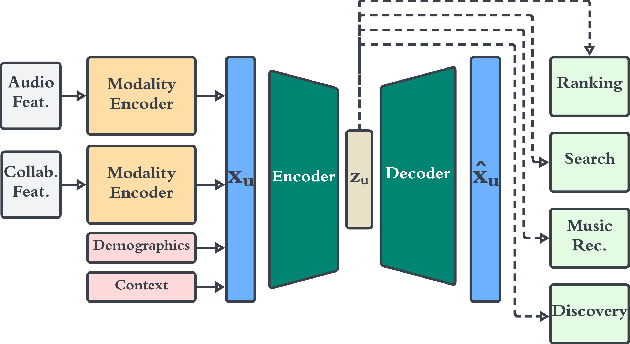

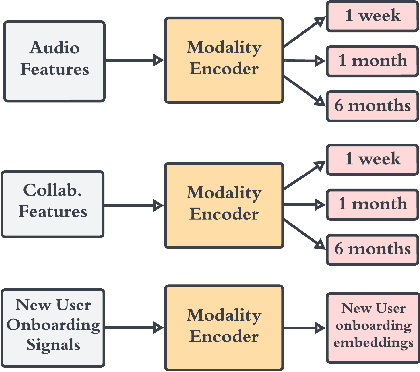

Abstract:We present a novel framework for user representation in large-scale recommender systems, aiming at effectively representing diverse user taste in a generalized manner. Our approach employs a two-stage methodology combining representation learning and transfer learning. The representation learning model uses an autoencoder that compresses various user features into a representation space. In the second stage, downstream task-specific models leverage user representations via transfer learning instead of curating user features individually. We further augment this methodology on the representation's input features to increase flexibility and enable reaction to user events, including new user experiences, in Near-Real Time. Additionally, we propose a novel solution to manage deployment of this framework in production models, allowing downstream models to work independently. We validate the performance of our framework through rigorous offline and online experiments within a large-scale system, showcasing its remarkable efficacy across multiple evaluation tasks. Finally, we show how the proposed framework can significantly reduce infrastructure costs compared to alternative approaches.
23.8 GHz Acoustic Filter in Periodically Poled Piezoelectric Film Lithium Niobate with 1.52 dB IL and 19.4% FBW
Feb 19, 2024Abstract:This paper reports the first piezoelectric acoustic filter in periodically poled piezoelectric film (P3F) lithium niobate (LiNbO3) at 23.8 GHz with low insertion loss (IL) of 1.52 dB and 3-dB fractional bandwidth (FBW) of 19.4%. The filter features a compact footprint of 0.64 mm2. The third-order ladder filter is implemented with electrically coupled resonators in 150 nm bi-layer P3F 128 rotated Y-cut LiNbO3 thin film, operating in second-order symmetric (S2) Lamb mode. The record-breaking performance is enabled by the P3F LiNbO3 platform, where piezoelectric thin films of alternating orientations are transferred subsequently, facilitating efficient higher-order Lamb mode operation with simultaneously high quality factor (Q) and coupling coefficient (k2) at millimeter-wave (mmWave). Also, the multi-layer P3F stack promises smaller footprints and better nonlinearity than single-layer counterparts, thanks to the higher capacitance density and lower thermal resistance. Upon further development, the reported P3F LiNbO3 platform is promising for compact filters at mmWave.
Short-lived High-volume Multi-A/B Testing
Dec 23, 2023Abstract:Modern platforms leverage randomized experiments to make informed decisions from a given set of items (``treatments''). As a particularly challenging scenario, these items may (i) arrive in high volume, with thousands of new items being released per hour, and (ii) have short lifetime, say, due to the item's transient nature or underlying non-stationarity that impels the platform to perceive the same item as distinct copies over time. Thus motivated, we study a Bayesian multiple-play bandit problem that encapsulates the key features of the multivariate testing (or ``multi-A/B testing'') problem with a high volume of short-lived arms. In each round, a set of $k$ arms arrive, each available for $w$ rounds. Without knowing the mean reward for each arm, the learner selects a multiset of $n$ arms and immediately observes their realized rewards. We aim to minimize the loss due to not knowing the mean rewards, averaged over instances generated from a given prior distribution. We show that when $k = O(n^\rho)$ for some constant $\rho>0$, our proposed policy has $\tilde O(n^{-\min \{\rho, \frac 12 (1+\frac 1w)^{-1}\}})$ loss on a sufficiently large class of prior distributions. We complement this result by showing that every policy suffers $\Omega (n^{-\min \{\rho, \frac 12\}})$ loss on the same class of distributions. We further validate the effectiveness of our policy through a large-scale field experiment on {\em Glance}, a content-card-serving platform that faces exactly the above challenge. A simple variant of our policy outperforms the platform's current recommender by 4.32\% in total duration and 7.48\% in total number of click-throughs.
Self-supervised Contrastive Learning for Irrigation Detection in Satellite Imagery
Aug 12, 2021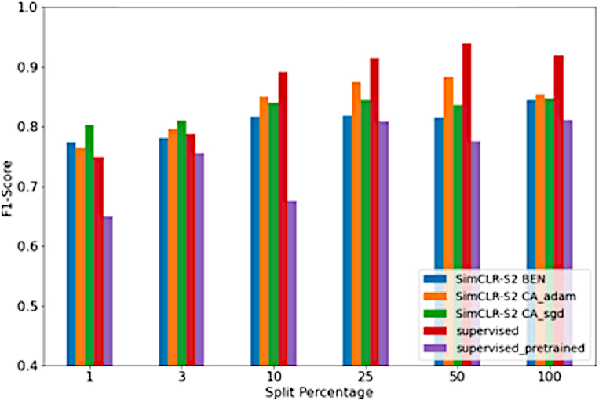
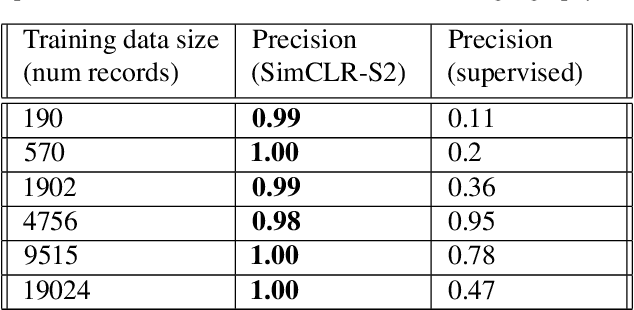
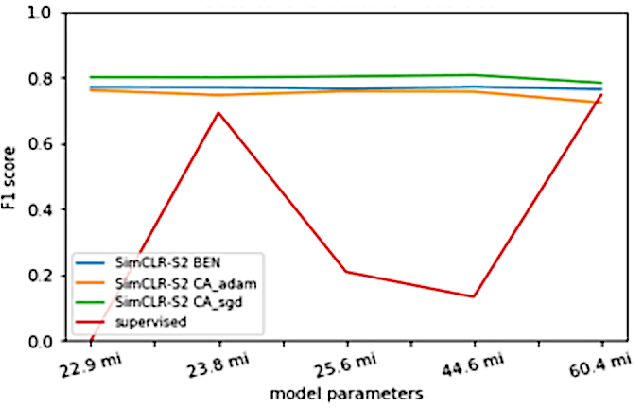
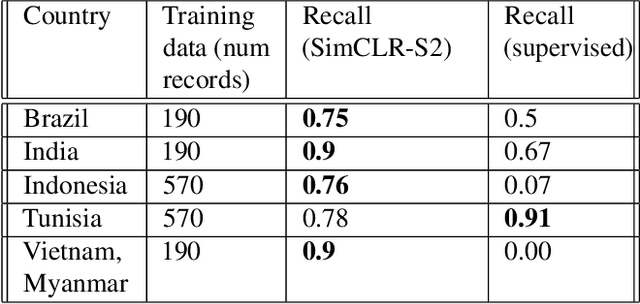
Abstract:Climate change has caused reductions in river runoffs and aquifer recharge resulting in an increasingly unsustainable crop water demand from reduced freshwater availability. Achieving food security while deploying water in a sustainable manner will continue to be a major challenge necessitating careful monitoring and tracking of agricultural water usage. Historically, monitoring water usage has been a slow and expensive manual process with many imperfections and abuses. Ma-chine learning and remote sensing developments have increased the ability to automatically monitor irrigation patterns, but existing techniques often require curated and labelled irrigation data, which are expensive and time consuming to obtain and may not exist for impactful areas such as developing countries. In this paper, we explore an end-to-end real world application of irrigation detection with uncurated and unlabeled satellite imagery. We apply state-of-the-art self-supervised deep learning techniques to optical remote sensing data, and find that we are able to detect irrigation with up to nine times better precision, 90% better recall and 40% more generalization ability than the traditional supervised learning methods.
 Add to Chrome
Add to Chrome Add to Firefox
Add to Firefox Add to Edge
Add to Edge